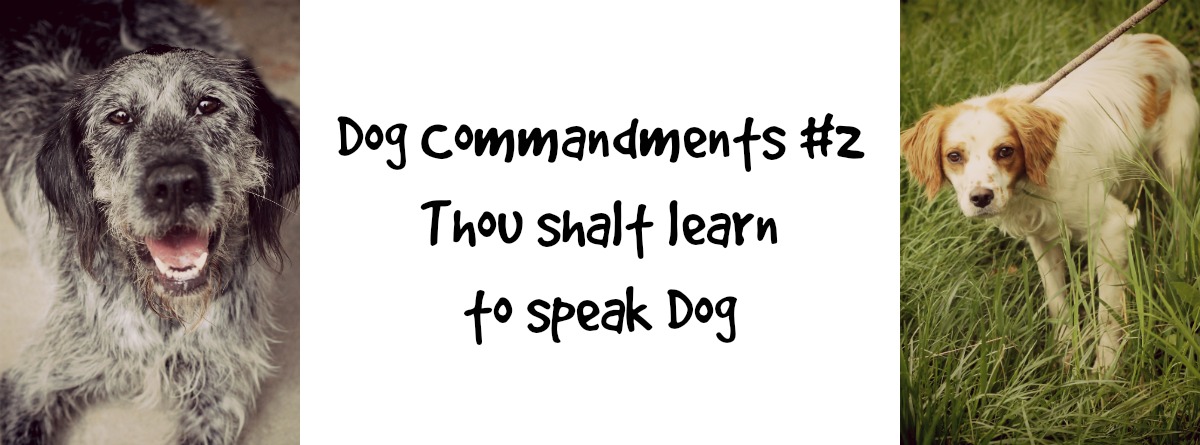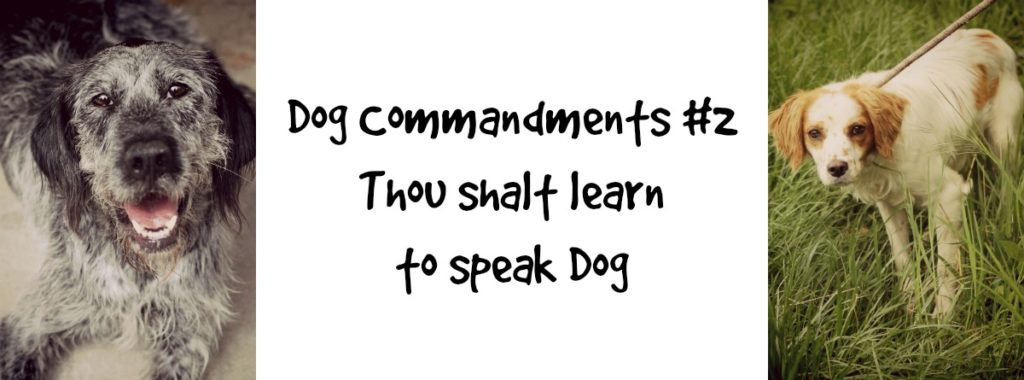After all, it’s only fair, since we spend most of our time trying to teach our dogs to speak Human (in fact, the Georgia Institute of Technology are in the process of helping dogs do exactly that)
We’re pretty good at recognising fear and aggression. Well, you’d think. The number of preventable dog bites every year are a good indicator that we’re not as good at recognising as we think we are when our dogs are shouting at us about how uncomfortable they feel. Personally, I am a big fan of letting dogs say as loud as they like that they aren’t comfortable, that they are afraid. It’s our way of knowing to back off. Barking and growling are their way of expressing themselves. I’m not so big a fan of people teaching their dogs not to express their fear or aggression, not to growl, not to show their teeth. These are precisely the dogs that go from calm to bite and make it really hard for us to know they are going to do so.
Take Tilly my American cocker. I know when she feels afraid. It’s when I’m going to take a prized possession off her. I get a growl, whites of eyes, bulging eyes, louder growls, teeth displays. This is great for other dogs, too. Nobody is unsure that Tilly doesn’t want you in her personal space, thank you very much. Everybody knows that Tilly doesn’t want you in her personal space, including all of my neighbours.
And then Tobby, my rescue Malinois. No visible difference in how he displays fear or excitement, never growls, occasionally barks at people, air snaps at dogs, but went from sitting to biting me in two seconds flat. I have never once heard him growl when I have puppies here. Tobby hates puppies. He hates them leaping and he hates them trying to play with him. He only ever tries to escape the garden when there are puppies here. But he never, ever growls at them. Tilly will growl and then she’ll really tell them off. Amigo will growl and they’ll pay him no mind, because nobody pays him any mind. Heston doesn’t care less. He’ll play with anybody, all day long. But Tobby hates the puppies, and they don’t know it. I only know it because he runs away. Dollars to donuts, somebody back in Tobby’s life taught him not to growl. That has big consequences because I would never trust him around children or in scary situations. I just can’t see the signs in him that he is afraid or not comfortable.
So if we’re fairly good at recognising the fear/aggression pathway – and we even might be tempted to stop our dogs showing those signs, why aren’t we quite as good at recognising how dogs calm each other down? Are there techniques we can use here ourselves to help them feel calm in our presence?
One of the best books about canine calming signals is Norwegian dog trainer Turid Rugaas’ book On Talking Terms with Dogs: Calming Signals. The only fault of the book is that it is too short. There are few books I say that about. At first, I’m all “bah, people can’t calm dogs down using body language!” and it sounds, quite frankly, like weird scandinavian hippy stuff. But then I look at the dogs I know, the dogs I work with, the people who interact with those dogs, and I’m forced to admit… there’s something. Actually, to give Cesar Millan his due, I see him using these sometimes too. And they work. Ironically, they’re the one thing he never talks about doing – he just does. He does the opposite of them too – which makes me cross, since if you can calm dogs down, you can certainly stir them up.
Take Heston at the vets the other week. From time to time – rarer and rarer – he will bark at someone in the street when we are out. We went in the vets. It’s a smelly, stressy, excited, fearful animal environment. Who knows how it smells to a dog?! Like a dog disco? Like a dog abattoir? Either way, walking into a room full of animals is not fun. This time, there were no animals. Just two ladies waiting. I know one of the ladies, though she pretends she doesn’t know me. We used to be on a council together, and she was voted off from being chair. To say she’s slightly hostile is a bit of an understatement. The other lady is a lady in her seventies. She is small, sitting down. Heston is pretty focused on me, on the vet nurses, and I see him gingerly approach the older lady. I ask if it’s okay. She says yes. She doesn’t look at him, she doesn’t touch him, look at him or speak to him, just lets him smell her hand. He licks her hand and comes back to me. No bark, no growl, no fear. The first lady stands up, her back against the window. She’s tall and she blocks out the light. I can’t see her face well because it’s dark in the room. But she’s eyeballing Heston. Heston looks at her, and he barks. Maybe he does it because she’s glowering at him, or he can’t see her expression so well. She tuts. He backs off and barks. I bring him back to me and ask him to sit down. He does, but he’s eyeing her all the time.
A man comes in, sits in the chair next to us. He doesn’t look at Heston, but we start chatting too. He says his dog is too excited to bring in. Heston approaches him and he goes in for a smell. The man does nothing, just lets him. He’s sitting, his face is relaxed, he’s not eyeballing him. Heston sits down right in front of him and lets him stroke him.
Heston’s mostly barky at the gate. Interrupted during a meal at aged 13 weeks by a person who just walked in to the house, he barked for five minutes and wouldn’t be calmed. He always barks now at anyone who comes in. Talk about a formative experience. And I don’t get enough houseguests to retrain him. Thus, he barks at people who come on to the property. This is partially okay with me. Barking at people on their property is what dogs do. Teaching them to differentiate between friends and strangers is hard. Teaching them to differentiate between good strangers and bad strangers is nigh-on impossible. A couple of weeks ago, he barked at a guy who came to drop something off. It’s the only time in his entire life that I ever thought he might bite the person, so I shut him in. The guy was small build, but the light was behind him and he just kept moving in, despite Heston barking. Heston was practically up against the front door which was closed behind him – he was cornered. The guy didn’t even seem to care. He’s someone who’s been here before and it’s clear that whilst he has dogs of his own, he doesn’t actually like dogs. I know his own dogs jump up at him, but he kneed Amigo in the chest when he got too close. The guy certainly makes me feel that my dogs (in my house, on my property) are out of control and aggressive, so I have no idea how that might impact on my dogs and what they think. Could Heston having been picking up on my feelings? Perhaps. Who knows. One thing is for sure, the guy had no idea how to calm a dog, and no desire to do so.
Another houseguest I had a while back knew exactly. He crouched sideways, almost kneeling, not looking at Heston, his back to him. Heston shut up almost immediately.
Reading Calming Signals and you start to understand what is going on here. Barbara Handelman’s amazing Canine Behavior is also great. Over 1000 images analysing dog body language and worth every penny.
As Turid Rugaas says, “Canine language in general consists of a large variety of signals using body, face, ears, tail, sounds, movement and expression.” She says that through understanding – and even replicating – these signals, we can improve our communication with our dogs. Calming Signals is about the signals that help manage conflict and calm situations. I’ve seen dogs do these, and I’ve seen people do them too. Knowing how dogs diffuse hostility or emotionally-charged situations, and knowing how some of the most intuitive and instinctive trainers work with dogs definitely can help you manage your dog’s behaviour better, as well as understanding what’s going on with your own family of dogs. She says these signals “make the others involved feel safer and understand the goodwill the signals indicate.”
So how do dogs calm each other? There are a good few in this video of Hoppy meeting some of my dogs. Hoppy is a two year old castrated bichon and he’s meeting Heston and Tobby for the first time. Hoppy is excited and a little nervous. Heston doesn’t dive straight into playing with him yet, even though Hoppy looks ready to play. There are lots of calming signals here from Heston (and never mind Wobbly Bob in the background completely avoiding the situation)
These are my top ten doggy calming signals, and many you will see in this short clip.
- Head turning. They avoid looking directly at the other dog, will look away. It’s the opposite of the full-frontal eyeball-stare. They look away. You can see Heston, my black dog, doing it with Hoppy at this meeting here. He could easily flatten Hoppy, but he turns away, still looking, but not head-on. Every time Hoppy gets in his face, Heston turns his head. It’s kind of play, but Heston finds it a bit too much, so he calms Hoppy. You see Hoppy does the same too, turning his head by the end of the short clip. My unrefined Heston is making Ralf feel a little uncomfortable in this photo, but you can see Ralf averting his gaze. I just don’t see you, fella!
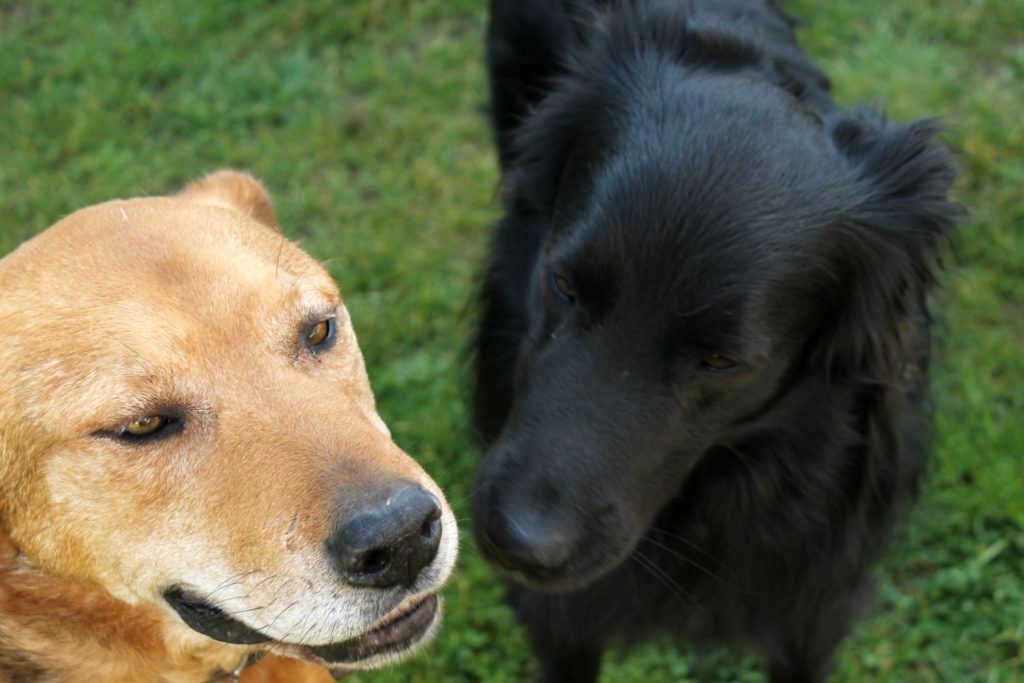
- Shortening the eye. I call this “happy eyes”, where they aren’t giving the full-on stare, but they are giving soft, happy eyes. Here you can see Jackpot with his “hard eyes” and his “happy eyes” – everything about Jackpot’s second photo shows that he looks more relaxed. You know that a 1000 yard stare is very different than “hello, how do you do?” eyes. Everything in the second shot is relaxed and calmer.
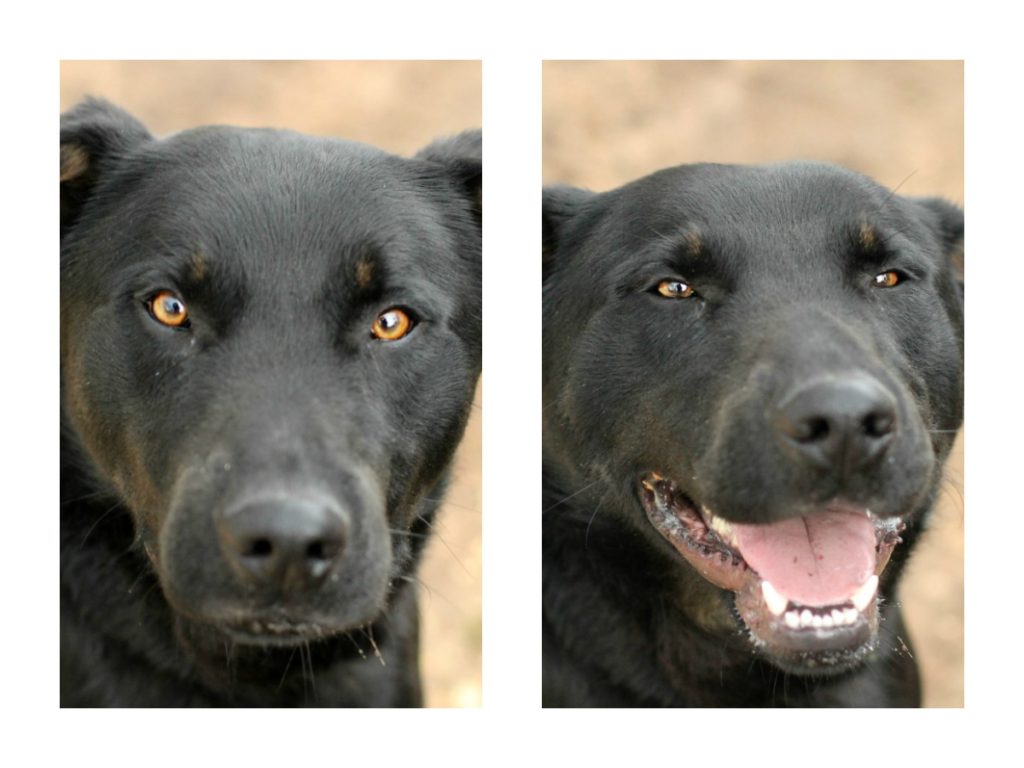
- Turning away. You can see Heston doing this with Hoppy in the video. He stands side on to calm the yapping (well, I might want to calm the yapping as well!) Hoppy is just excited, not aggressive, but even though this is Heston’s territory, you can see him calming Hoppy down. He’s a bit mixed signals – some eyeball to eyeball, and big tails – but he is telling Hoppy that he isn’t a threat.
- Turning your back completely. This is a great one for humans to do as well. It is single-handedly the easiest way to stop a dog jumping. It also avoids that eyeball staring and the tension of face-to-face conflict.
- Tongue flicks. Dogs use tongues in lots of ways. You can see Tobby do it really quickly as he comes up behind Heston in the first second of the video. Sure, a tongue can say “lovely cheese” but it can also shows that a dog is a little uncomfortable. I get a lot when I photograph dogs. It can be “hey, lovely cheese lady” but it can also be “strange lady” and “strange noisy black eye thing”. For Tobby it’s all “woah! Small shouty dog alert!”
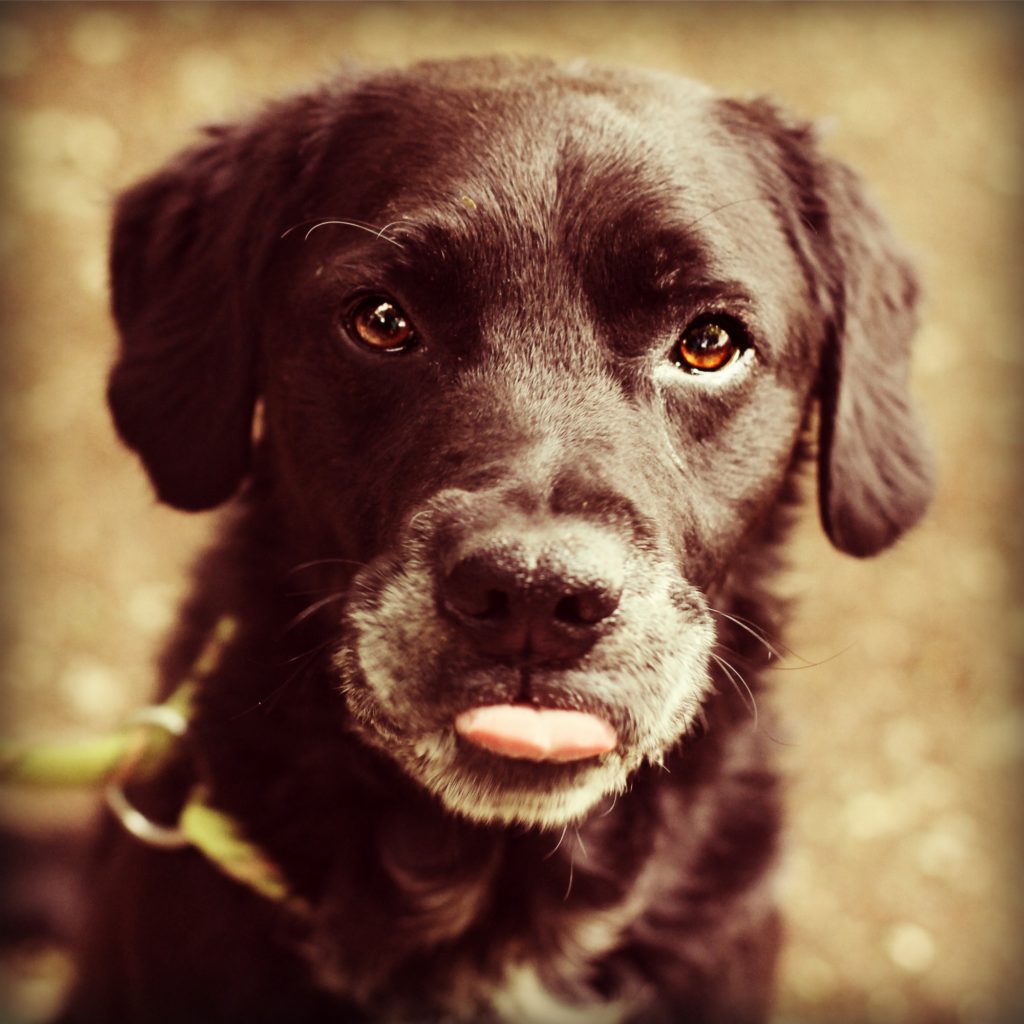
- Exaggerated slowness or freezing. A dog who moves more slowly than usual can be trying to make themselves look innocuous and inoffensive. They don’t seem to want to do anything sudden or surprising that might make the other dog feel worried or fearful.
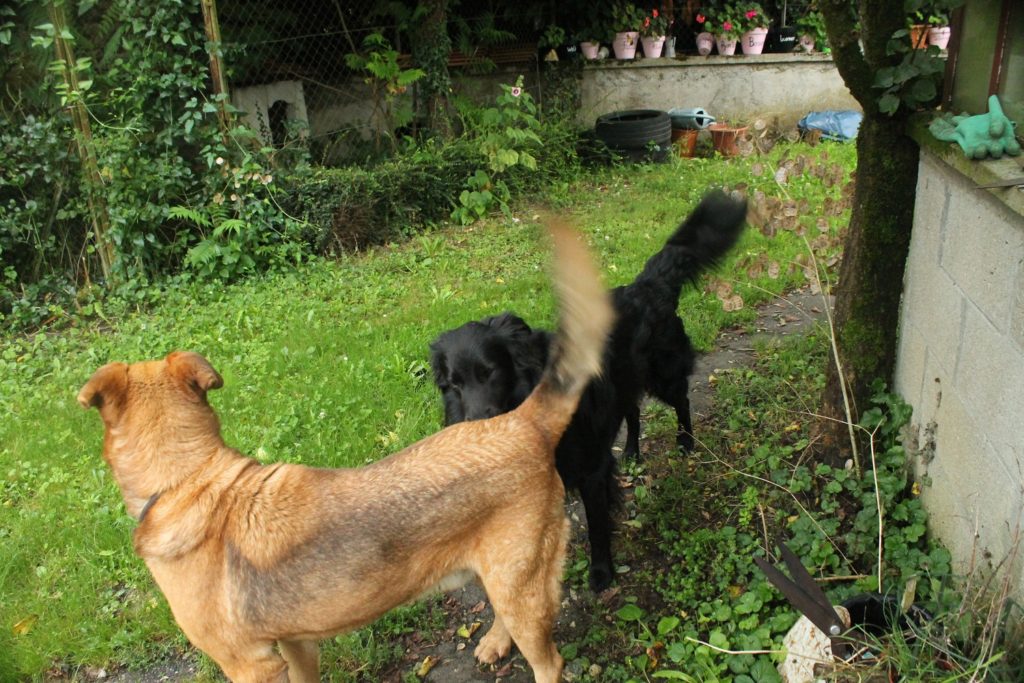
This is the first meeting between Ralf and Heston. Ralf stood very still, side on, and let Heston smell him. It totally diffused Heston and all that meet-and-greet energy. His tail is high and he’s wagging quickly, but he lets Heston have a smell and it calms both of them down. - Play bow. I love play bow. A slow play bow is a real tension diffuser and shows that a dog has friendly intentions. Here, you can see Hista doing it with Galaxy, who is a little wary of her.
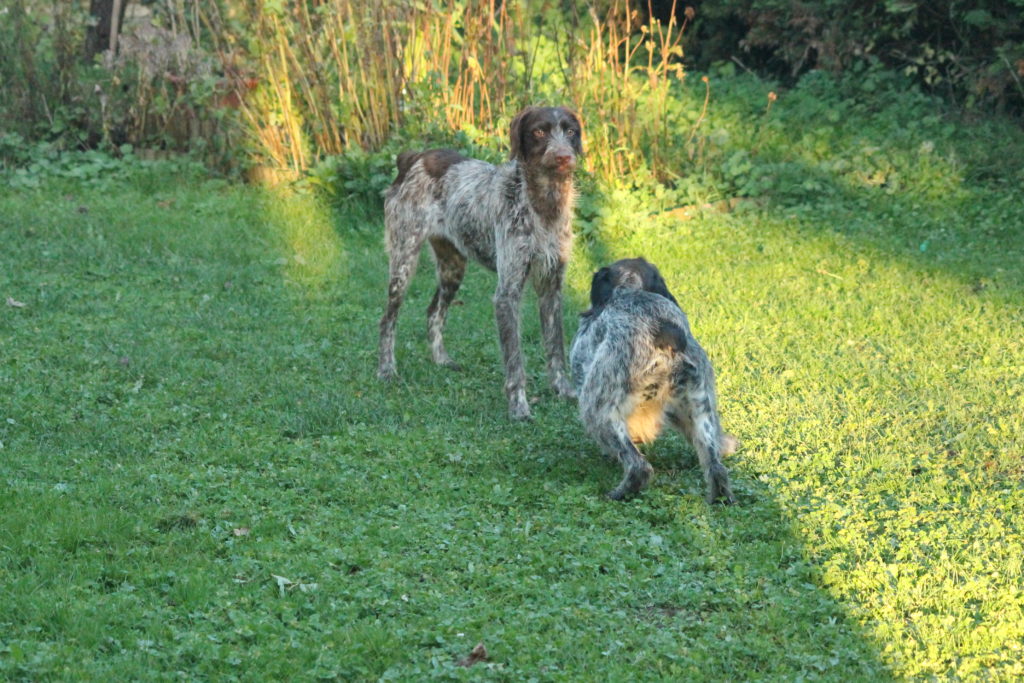
You can see Galaxy is stiff and alarmed, her ears pinned and her eyes big with some concern.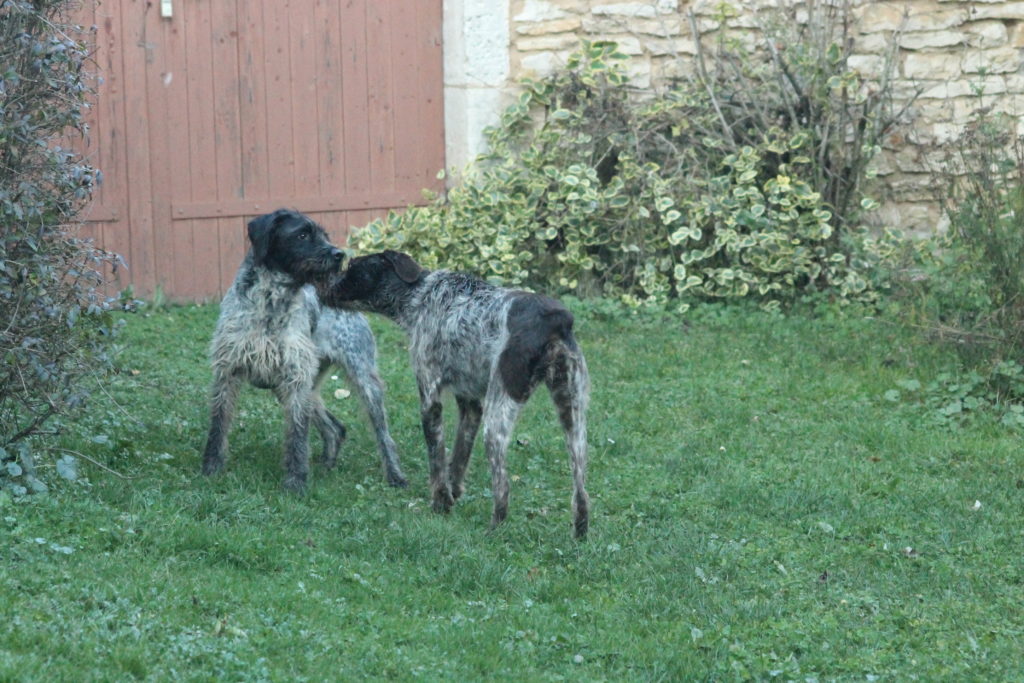
So Hista turns sideways, averts her eyes, becomes very still and lets Galaxy have a smell, which convinces Galaxy that Hista is a great new playmate. Two minutes later and they’re playing happily. - Shake off. One of the most common signals we see at the refuge is the “shake off”. This happens most often when we’ve just done the ‘walk of shame’ past all the other dogs to get out for a walk. At the gate, where there are fewer people and dogs, many dogs give a good shake off.
- Walking in an arc. I once heard of a local trainer who meets dogs and makes them walk face-to-face on the lead towards one another. I can’t think of a worse thing to do with dogs, or a situation that deliberately puts them in conflict with one another. To calm an approaching dog, other dogs will often walk in an arc away from them. You can see Tobby doing it here behind Heston. He never even looks at Hoppy. He walks in such an arc that he almost walks into the chair (not unusual for my spatially-challenged ‘Crash Bang’) but you can see him looking to me for reassurance as he completes his arc. At the very beginning of the video, both Heston and Tobby are coming directly to me. When Hoppy comes face on to them, both of them change direction. Heston’s hanging around. He wants contact with Hoppy, and he enjoys playing. He’s certainly big enough to handle a small yappy dog. He’s just throwing out a few things to diffuse Hoppy, which happens in a mere nine seconds!
- Yawning. I used to have a dog that I could make yawn on cue. I only had to yawn at her and she would yawn back. It worked for sighs as well. First, I thought that was just a cool thing that she did. Now I know that it is a way dogs calm themselves and each other. I don’t have any sympathetic yawners any more, but Tobby and Heston both do great big sighs when we’re chilling out.
When you study how dogs calm themselves and others, you can see the multitude of signals they give to avert conflict. Far from being shouty maniacs, most dogs will give lots of these signals to diffuse a situation and make it less tense. These signs can show nervousness and self-soothing, and they can also be things dogs do in our presence. I certainly get a bit of this when I’m there with my camera.
Now I am not suggesting that all of these are things you can or should replicate yourself, but I certainly find it to be true that in initial meetings, dogs are less reactive to humans who give off calming signals. Ironically, by the way, or perhaps very much in line with this, is the fact that a lot of these things are gestures you are asked to make around sumo wrestlers so you don’t offend them. When I spent some time in a judo ring in Kyoto, we watched some sumo. Do you know you aren’t supposed to look directly at a sumo wrestler? You must be quiet around them, never look directly at them, never point your feet at them, keep a lot of space, never point your fingers at them, or use big gestures or hand movements. I could go on but you would think it very weird indeed.
I think these things are very true of dogs too.
Approach a dog like you would approach a respected Japanese sumo wrestler and you can’t go far wrong. I’m a big fan of averted eyes, small movements, going side on or putting my back to a dog. When I’ve got 1000€ of equipment and two bouncy off-lead labradors, the last thing I want is a smashed lens, so I often go in backwards to the outdoor spaces and just stand until the dogs lose interest in me. In a world where people bring a) food b) walks or c) play, it’s understandable that a dog who has perhaps had 20 minutes of people time in that day might be excited. It’s understandable for many dogs who have perhaps never had contact with humans if they were pack dogs for hunting, or for dogs who have suffered at the hands of humans, or whose only experience is being brought relatively traumatically to the refuge, that they may be stressed around people. Replicating some of these is the greatest way to calm an animal.

